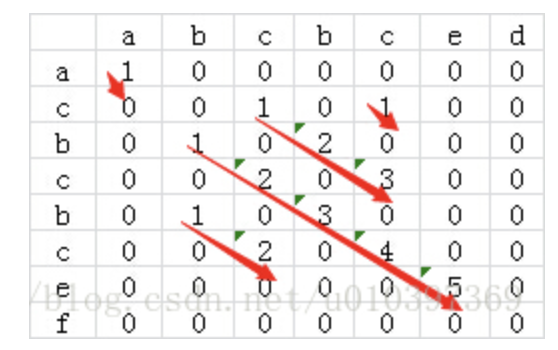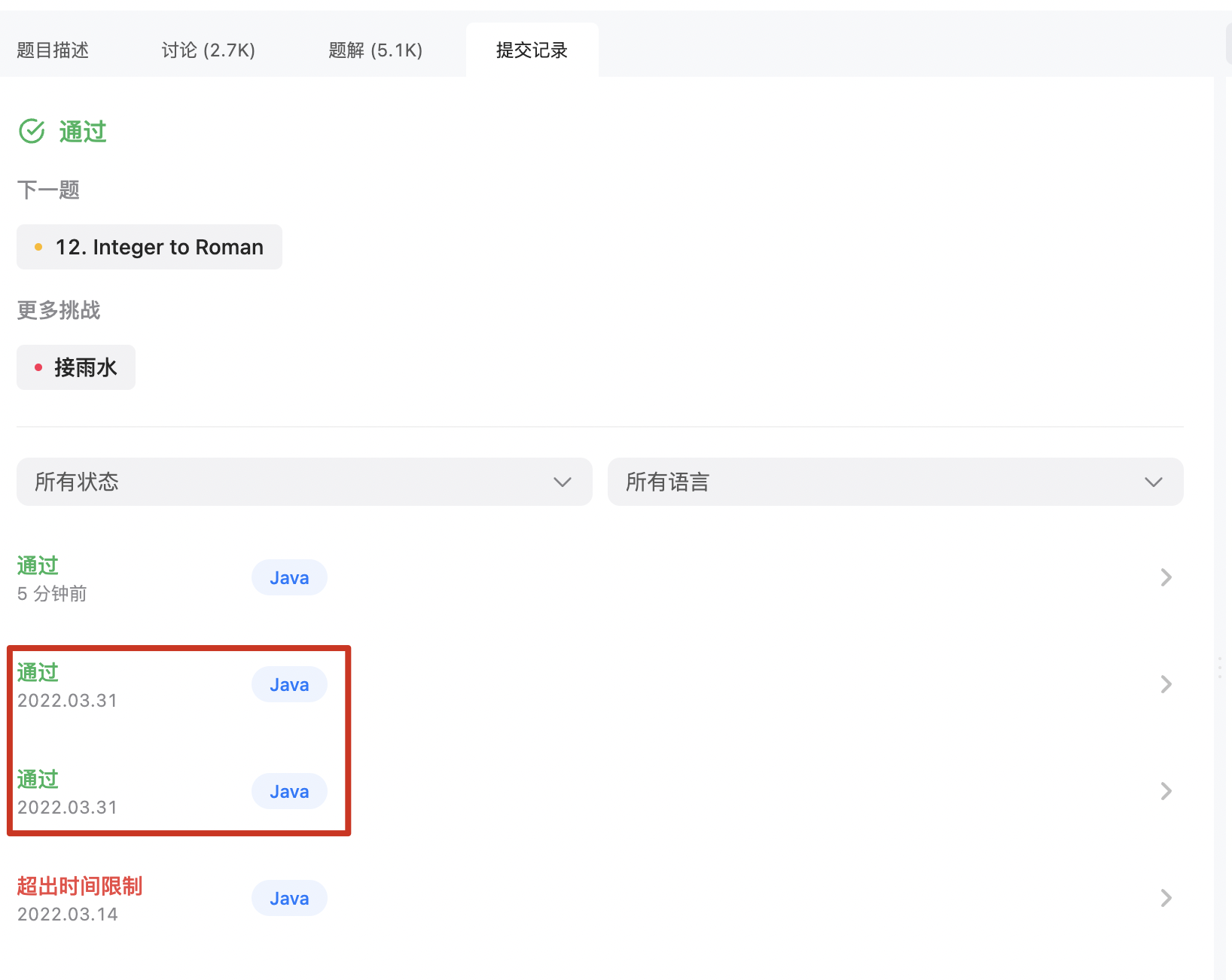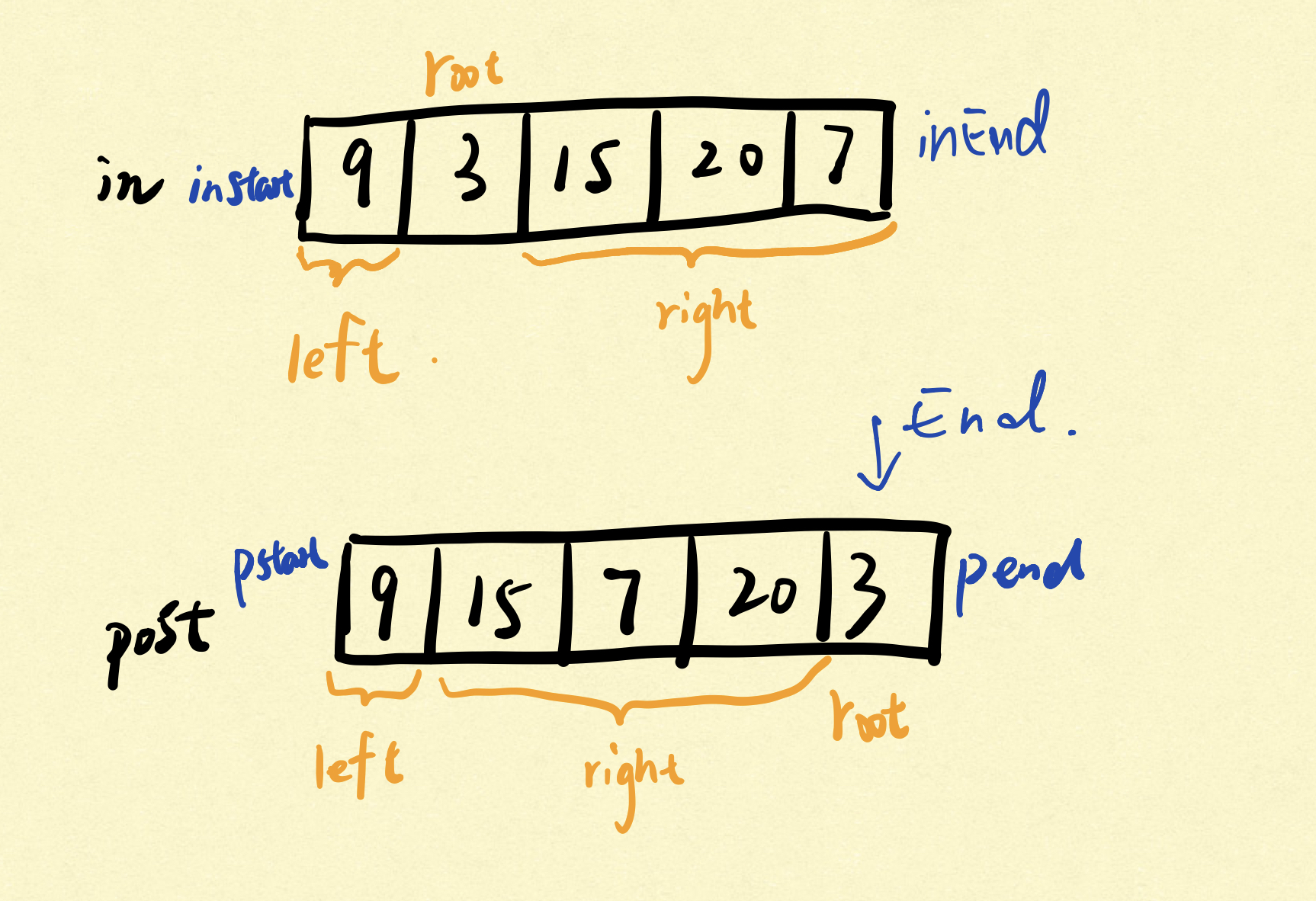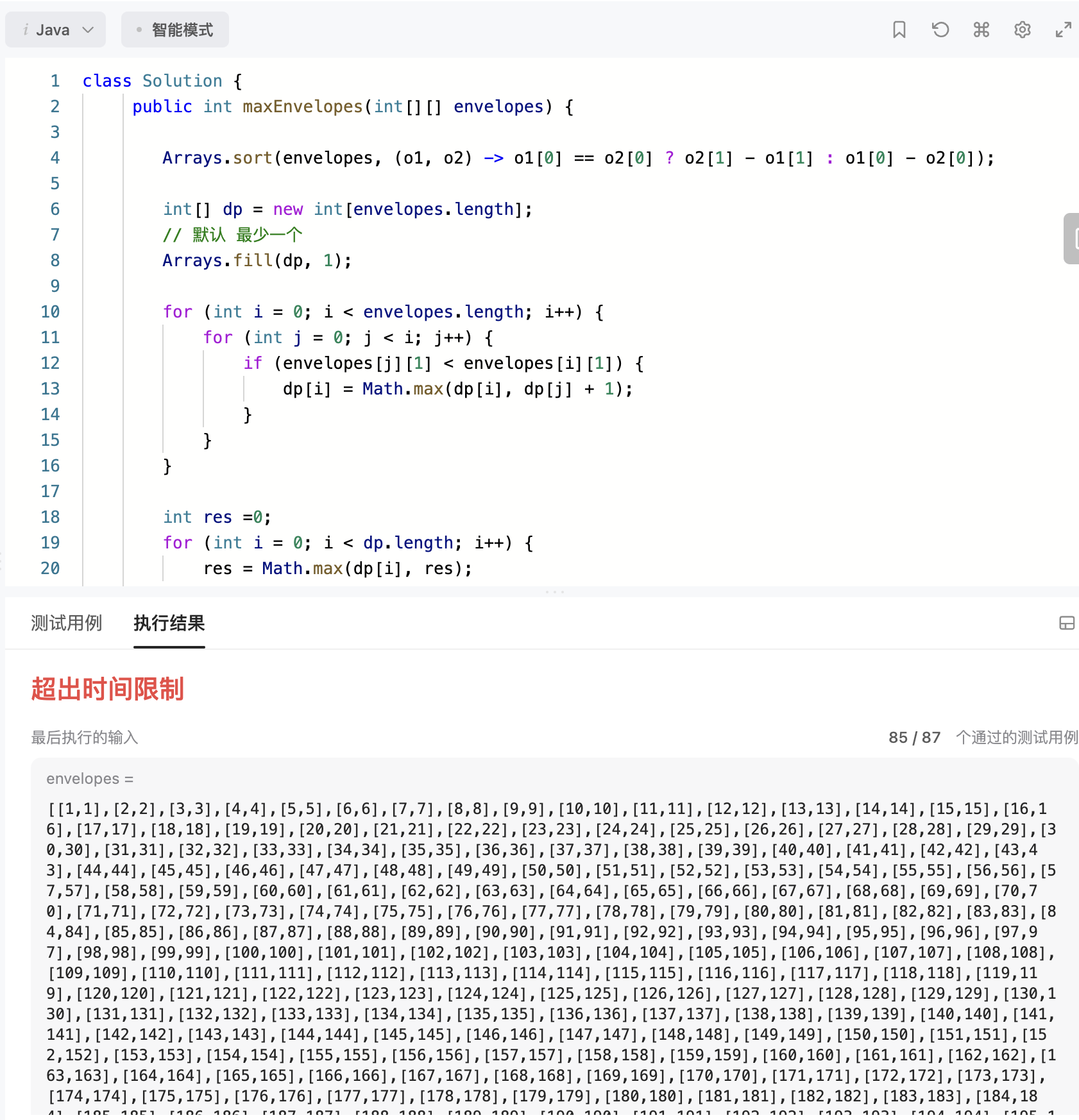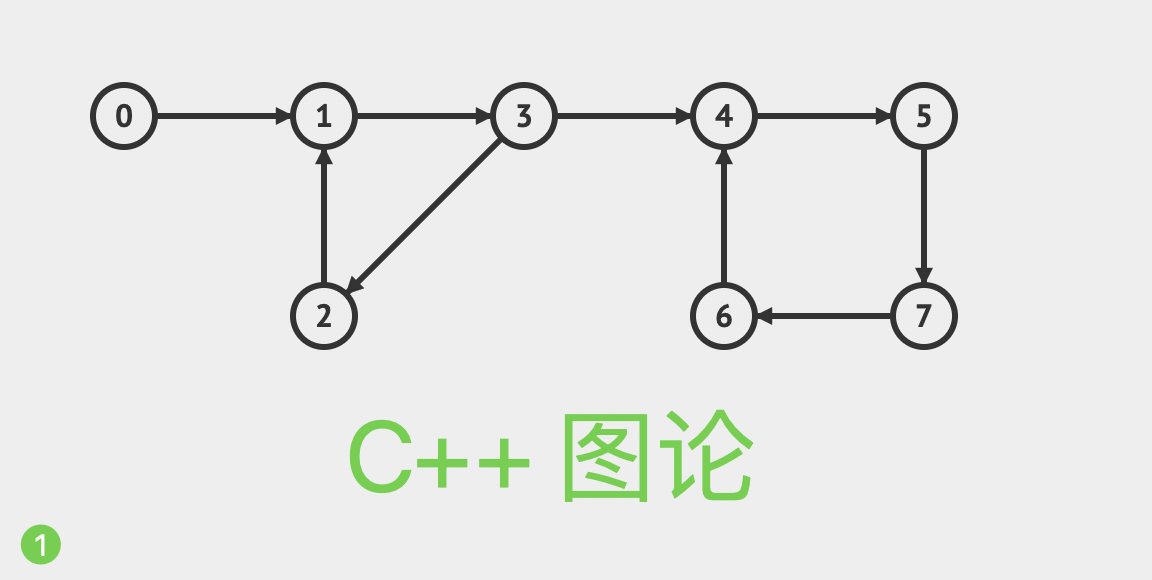[TOC]
思路
嵌套两次循环 O(n*n)
两个一次循环 O(2n)
一次循环
两个一次循环 O(2n)
第一次循环用 hashmap 存储所给的数据
第二次循环用 target - 当循环当前的值得到sub,判断 sub 是否在 map 中,同时 sub 不能是当前的值
1 2 3 4 5 6 7 8 9 10 11 12 13 public static int [] twoSum(int [] nums, int target) { Map<Integer, Integer> cache = new HashMap<>(); for (int i = 0 ; i < nums.length; i++) { cache.put(nums[i], i); } for (int i = 0 ; i < nums.length; i++) { int sub = target - nums[i]; if (cache.containsKey(sub) && cache.get(sub) != i) { return new int []{i, cache.get(sub)}; } } return null ; }
一次循环
将两次循环合并,不用判断当前的值和 sub 是否一样,只将遍历到的值存入 map 中。
1 2 3 4 5 6 7 8 9 Map<Integer, Integer> cache = new HashMap<>(); for (int i = 0 ; i < nums.length; i++) { int sub = target - nums[i]; if (cache.containsKey(sub)) { return new int []{i, cache.get(sub)}; } cache.put(nums[i] , i); } return null ;
思路 一开始想的是遍历两个链表,把他们变成十进制数,然后相加,最后再把这个数转化成链表,但是题目给的条件是 [1,100] 位数的范围,传统的 64 位 用java 是表示不出来的。
同时遍历两个链表,在相同长度内相加,进位传递下一次遍历
如果有一个链表遍历结束,以后它所有的 val 值都是 0
code 1 2 3 4 5 6 7 8 9 10 11 12 13 14 15 16 17 18 19 20 21 22 23 24 25 26 27 28 29 30 31 32 33 34 35 36 37 38 39 40 41 42 43 44 45 46 47 48 49 50 51 52 53 54 55 56 57 58 59 60 61 62 63 64 65 66 67 68 69 70 71 72 73 74 75 76 77 78 79 80 81 82 83 84 85 86 public class PRC_02 public static class ListNode int val; ListNode next; ListNode() { } ListNode(int val) { this .val = val; } ListNode(int val, ListNode next) { this .val = val; this .next = next; } } public static ListNode addTwoNumbers (ListNode l1, ListNode l2) int digit = 0 ; ListNode head = new ListNode(0 ); ListNode cur = head; while (l1 != null || l2 != null ) { int x = l1 != null ? l1.val : 0 ; int y = l2 != null ? l2.val : 0 ; int val = digit > 0 ? (x + y + digit) : (x + y); digit = val / 10 ; cur.next = new ListNode(val % 10 ); cur = cur.next; if (l1 != null ) l1 = l1.next; if (l2 != null ) l2 = l2.next; } if (digit != 0 ) { cur.next = new ListNode(digit); } return head.next; } public static void main (String[] args) ListNode n1 = new ListNode(4 , null ); ListNode n2 = new ListNode(6 , n1); ListNode n3 = new ListNode(5 , n2); ListNode n4 = new ListNode(3 , null ); ListNode n5 = new ListNode(4 , n4); ListNode n6 = new ListNode(2 , n5); ListNode listNode = addTwoNumbers(n3, n6); System.out.println(1 ); } }
思路 一开始看到无重复是想用 Set, 然后用两层循环,最后打出 Set 的长度,但是吧,我不喜欢用两次循环,所以考虑到了双指针。
用双指针(滑动窗口)确定字符串的连续
用 Set 确保不重复
用一个变量确定最长的长度
AC ( 待优化) 1 2 3 4 5 6 7 8 9 10 11 12 13 14 15 16 17 18 19 20 21 22 23 24 25 26 27 28 29 30 31 32 33 34 35 36 37 public class PRC_03 public static int lengthOfLongestSubstring (String s) char [] chars = s.toCharArray(); int length = chars.length; int left = 0 ; int right = 0 ; int maxlength = 0 ; Set<Character> set = new HashSet<>(); while (left <= right && right < length) { if (set.add(chars[right])) { maxlength = Math.max(maxlength, right - left + 1 ); right++; continue ; } set.clear(); left++; right = left; } return maxlength; } public static void main (String[] args) System.out.println(lengthOfLongestSubstring("abcabcbb" )); System.out.println(lengthOfLongestSubstring("bbbbb" )); System.out.println(lengthOfLongestSubstring("pwwkew" )); System.out.println(lengthOfLongestSubstring("au" )); System.out.println(lengthOfLongestSubstring("aab" )); System.out.println(lengthOfLongestSubstring("dvdf" )); } }
思路
AC 1 2 3 4 5 6 7 8 9 10 11 12 13 14 15 16 17 18 19 20 21 22 23 24 25 26 27 28 29 30 31 32 33 34 35 36 37 38 39 40 41 42 43 44 45 46 47 48 49 50 51 52 53 54 55 public class PRC_04 public static double findMedianSortedArrays (int [] nums1, int [] nums2) int [] merge = merge(nums1, nums2); int length = merge.length; return length % 2 == 0 ? (double ) (merge[length / 2 - 1 ] + merge[length / 2 ]) / 2 : merge[length / 2 ]; } public static int [] merge(int [] nums1, int [] nums2) { int [] merged = new int [nums1.length + nums2.length]; int left = 0 ; int right = 0 ; int index = 0 ; while (left < nums1.length || right < nums2.length) { if (left >= nums1.length) { merged[index++] = nums2[right]; right++; } else if (right >= nums2.length) { merged[index++] = nums1[left]; left++; } else if (nums1[left] < nums2[right]) { merged[index++] = nums1[left]; left++; } else { merged[index++] = nums2[right]; right++; } } return merged; } public static void main (String[] args) int [] nums1 = new int []{1 , 3 }; int [] nums2 = new int []{2 }; double medianSortedArrays = findMedianSortedArrays(nums1, nums2); System.out.println(medianSortedArrays); } }
思路
对称结构,我想中间往外拓展的查找,但是发现逻辑比较繁琐
双重循环,很笨重的方法
最终没有写出来,参考的别人动态规划的思路,既然是回文数,那它字符串自身反转也是拥有着这个回文数的,用一个对称的二维数据,去计算结果
AC(动态规划,求最长公共字串,最后找回文) 1 2 3 4 5 6 7 8 9 10 11 12 13 14 15 16 17 18 19 20 21 22 23 24 25 26 27 28 29 30 31 32 33 34 35 36 37 38 39 40 41 42 43 44 45 46 47 48 49 50 51 52 53 54 55 56 57 58 59 60 61 62 63 64 65 66 public class PRC_05 public static String longestPalindrome (String s) if (s.equals("" )){ return "" ; } StringBuilder reverse = new StringBuilder(s).reverse(); int n = s.length(); int [][] arr = new int [n + 1 ][n + 1 ]; int left = 0 ; int right = 0 ; int max = 0 ; for (int i = 1 ; i <=n; i++) { for (int j = 1 ; j <= n; j++) { if (s.charAt(i - 1 ) == reverse.charAt(j - 1 ) ) { arr[i][j] = arr[i - 1 ][j - 1 ] + 1 ; }else { arr[i][j] = 0 ; } if ( arr[i][j] > max ){ int beforeRev = n - j - 1 - 1 ; if (beforeRev + arr[i][j] + 1 + 1 == i ) { max = arr[i][j]; left = i - max ; right = i ; } } } } return s.substring(left , right ); } public static void main (String[] args) String s = "aacabdkacaa" ; System.out.println(longestPalindrome(s)); } }
AC 中心扩展 1 2 3 4 5 6 7 8 9 10 11 12 13 14 15 16 17 18 19 20 21 22 23 24 25 26 class Solution public String longestPalindrome (String s) int maxLength = 0 ; String res = "" ; for (int i = 0 ; i < s.length(); i++) { String s1 = centerExpand(s, i, i); String s2 = centerExpand(s, i, i + 1 ); String max = s1.length() > s2.length() ? s1 : s2; if (max.length() > maxLength) { maxLength = max.length(); res = max; } } return res; } public String centerExpand (String s, int left, int right) while (left >= 0 && right < s.length() && s.charAt(left) == s.charAt(right)) { left --; right ++; } return s.substring(left + 1 , right); } }
回溯,超时间复杂度,就是 Cn3,然后去重嘛
双指针
AC(自己两年的代码,现在的我竟然看不懂,而且写不出来) 1 2 3 4 5 6 7 8 9 10 11 12 13 14 15 16 17 18 19 20 21 22 23 24 25 26 27 28 29 30 31 32 33 34 35 36 37 38 39 40 41 42 43 44 45 46 47 public class PRC_15 public static List<List<Integer>> threeSum(int [] nums) { int n = nums.length; Arrays.sort(nums); List<List<Integer>> ret = new ArrayList<>(); for ( int first = 0 ; first < n ; first++){ if ( first > 0 && nums[first]==nums[first-1 ]){ continue ; } int third = n -1 ; int target = -nums[first]; for ( int second = first + 1 ; second < n ; second++){ if (second > first + 1 && nums[second]==nums[second-1 ]){ continue ; } while ( second < third && nums[second ]+ nums[third ] > target){ third--; } if (third==second){ break ; } if (nums[third] + nums[second]== target){ ret.add(List.of(nums[first], nums[second], nums[third])); } } } return ret; } public static void main (String[] args) int [] array = new int []{1 ,1 ,-2 }; List<List<Integer>> lists = threeSum(array); System.out.println(1 ); } }
思路
参考最长子序列,用一个二维数组存储,但是空间超标
换一个 dp 的思路, dp[i] 当前是 前 i 个最大的子串和,如果 dp[i - 1] < 0 说明,i - 1 之前最大都是负数,那么就舍去它,换上当前元素的值,只要用 max 和 dp[i] (也就是 nums[i]) 做比较,就能算出最大值
如果 dp[i - 1] > 0 那就加上 nume[i] , 算出第 i 长的子序最大值。
AC 1 2 3 4 5 6 7 8 9 10 11 12 13 14 15 16 17 18 19 20 21 22 23 24 25 26 27 28 29 30 31 public class PRC_53 public static int maxSubArray (int [] nums) int n = nums.length; int max = nums[0 ]; int [] dp = new int [n]; dp[0 ] = nums[0 ]; for (int i = 1 ; i <n ; i++) { if (dp[i - 1 ] < 0 ) { dp[i] = nums[i]; }else { dp[i] = dp[i - 1 ] + nums[i]; } max = Math.max(dp[i], max); } return max; } public static void main (String[] args) int [] nums = new int []{-2 , 1 , -3 , 4 , -1 , 2 , 1 , -5 , 4 }; System.out.println(maxSubArray(nums)); } }
思路
不动脑子思路,直接 api 往死里dui
取余取整数,循环位移,记得判断溢出
AC(不动脑子做法) 1 2 3 4 5 6 7 8 9 10 11 12 13 14 15 16 17 18 19 20 21 22 23 24 25 26 27 28 29 30 31 32 33 public class PRC_07 public static int reverse (int x) boolean negative = x < 0 ; String s = String.valueOf(x); StringBuilder builder = new StringBuilder(); int zeroIndex = Integer.MIN_VALUE; for (int i = s.length() - 1 ; i >= 0 ; i--) { if (s.charAt(i) != 0 ){ zeroIndex = i; break ; } } for (int i = zeroIndex ; i >= 0 ; i--) { if (s.charAt(i) == '-' ){ continue ; } builder.append(s.charAt(i)); } String s1 = negative ? "-" +builder.toString() : builder.toString(); int i = 0 ; try { i = Integer.parseInt(s1); } catch (NumberFormatException e) { return 0 ; } return i; } public static void main (String[] args) System.out.println(reverse(1534236469 )); } }
思路
空间排除法
双指针思路,短板确定最大的容器大小,所以短板之后所有的只会小于等于当前的容器大小
我们要确定左右那个到底是短板,然后根据短板的位置进行对应的移动
右边的短板,那就左移动,左边是短板,那就右移动,直到双指针相遇
短板的移动,可以获得未来的不确定性,将当前的 maxSize 和不确定性的大小做比较
优秀题解
AC
1 2 3 4 5 6 7 8 9 10 11 12 13 14 15 16 17 18 19 20 21 22 23 24 25 26 27 28 29 30 31 32 33 34 public class PRC_11 public static int maxArea (int [] height) int left = 0 ; int right = height.length - 1 ; int maxSize = Integer.MIN_VALUE; while (left < right) { maxSize = height[left] < height[right] ? Math.max(maxSize, (right - left) * height[left++]) : Math.max(maxSize, (right - left) * height[right--]); } return maxSize; } public static void main (String[] args) int [] height = new int []{1 ,8 ,6 ,2 ,5 ,4 ,8 ,3 ,7 }; System.out.println(maxArea(height)); } }
思路
DP, 找到当前列左边最大,和右边最大,取两者最小的
然后和当前的height 比较,如果大于当前 height 就 sum +, 否则 continue
AC 1 2 3 4 5 6 7 8 9 10 11 12 13 14 15 16 17 18 19 20 21 22 23 24 25 26 27 28 29 30 31 32 33 public class PRC_42 public static int trap (int [] height) int [] max_left = new int [height.length]; int [] max_right = new int [height.length]; int sum = 0 ; for (int i = 1 ; i < height.length - 1 ; i++) { max_left[i] = Math.max(height[i - 1 ], max_left[i - 1 ]); } for (int i = height.length - 2 ; i >= 0 ; i--) { max_right[i] = Math.max(height[i + 1 ], max_right[i + 1 ]); } for (int i = 1 ; i < height.length - 1 ; i++) { int min = Math.min(max_right[i], max_left[i]); if (min > height[i]) { sum += min - height[i]; } } return sum; } public static void main (String[] args) int [] height = new int []{0 , 1 , 0 , 2 , 1 , 0 , 1 , 3 , 2 , 1 , 2 , 1 }; System.out.println(trap(height)); } }
思路
AC 1 2 3 4 5 6 7 8 9 10 11 12 13 14 15 16 17 18 19 20 21 22 23 24 25 26 public class PRC_20 public static boolean isValid (String s) Stack<Character> stack = new Stack<>(); stack.push(s.charAt(0 )); for (int i = 1 ; i < s.length(); i++) { if (!stack.isEmpty() && (s.charAt(i) - stack.peek() == 1 || s.charAt(i) - stack.peek() == 2 )) { stack.pop(); }else { stack.push(s.charAt(i)); } } return stack.isEmpty(); } public static void main (String[] args) String s = "({[)" ; System.out.println(isValid(s)); } }
树专题 思路
解法一,记录当前遍历的层数,取最大值
解法二,分解为左右子树的子问题,子树最大的 depth + 1
层序遍历
AC(M1) 1 2 3 4 5 6 7 8 9 10 11 12 13 14 15 16 17 18 19 20 21 22 23 24 25 26 27 28 29 30 31 32 33 34 35 36 37 38 39 40 41 42 43 44 45 46 47 48 49 50 51 52 53 54 55 56 public class PRC_104 int maxDepth; int curDepth; public int maxDepth (TreeNode root) traverse(root); return maxDepth; } public void traverse (TreeNode node) if (node == null ) { return ; } curDepth++; if (node.left == null && node.right == null ) { maxDepth = Math.max(maxDepth, curDepth); } traverse(node.left); traverse(node.right); curDepth--; } public static void main (String[] args) PRC_104 prc104 = new PRC_104(); TreeNode treeNode3 = new TreeNode(3 ); TreeNode treeNode9 = new TreeNode(9 ); TreeNode treeNode20 = new TreeNode(20 ); TreeNode treeNode15 = new TreeNode(15 ); TreeNode treeNode7 = new TreeNode(7 ); treeNode3.left = treeNode9; treeNode9.left = null ; treeNode9.right = null ; treeNode15.right = null ; treeNode15.left = null ; treeNode7.right = null ; treeNode7.left = null ; treeNode3.right = treeNode20; treeNode20.left = treeNode15; treeNode20.right = treeNode7; int i = prc104.maxDepth(treeNode3); System.out.println("Max depth : " + i); } }
AC(M2) 1 2 3 4 5 6 7 8 9 public int maxDepth2 (TreeNode root) if (root == null ) { return 0 ; } int maxLeft = maxDepth(root.left); int maxRight = maxDepth(root.right); return Math.max(maxLeft, maxRight) + 1 ; }
思路
AC(M1) 1 2 3 4 5 6 7 8 9 10 11 12 13 14 15 16 17 18 19 20 21 public class PRC_144 public List<Integer> preorderTraversal (TreeNode root) List<Integer> res = new ArrayList<>(); traverse(root, res); return res; } public void traverse (TreeNode node, List<Integer> preOrderList) if (node == null ) { return ; } preOrderList.add(node.val); traverse(node.left, preOrderList); traverse(node.right, preOrderList); } }
AC(M2) 1 2 3 4 5 6 7 8 9 10 11 12 13 public List<Integer> preorderTraversal (TreeNode root) List<Integer> res = new ArrayList<>(); if (root == null ) { return res; } res.add(root.val); res.addAll(preorderTraversal(root.left)); res.addAll(preorderTraversal(root.right)); return res; }
AC(M3) 1 2 3 4 5 6 7 8 9 10 11 12 13 14 15 16 17 18 19 20 21 22 public int maxDepth3 (TreeNode root) if (root == null ) { return 0 ; } Queue<TreeNode> queue = new LinkedList<>(); queue.offer(root); int count = 0 ; while (!queue.isEmpty()){ int size = queue.size(); for (int i = 0 ; i < size; i++) { TreeNode curNode = queue.poll(); if (curNode.left != null ) { queue.offer(curNode.left); } if (curNode.right != null ) { queue.offer(curNode.right); } } count++ ; } return count; }
思路
AC 1 2 3 4 5 6 7 8 9 10 11 12 13 14 15 16 17 18 19 20 public class PRC_543 int maxDiameter ; public int diameterOfBinaryTree (TreeNode root) maxDepth(root); return maxDiameter; } public int maxDepth (TreeNode root ) if (root == null ) return 0 ; int maxLeft = maxDepth(root.left); int maxRight = maxDepth(root.right); int curDiameter = maxLeft + maxRight; maxDiameter = Math.max(curDiameter, maxDiameter); return Math.max(maxLeft, maxRight) + 1 ; } }
思路
AC(M1) 1 2 3 4 5 6 7 8 9 10 11 12 13 14 15 16 17 18 public class PRC_226 public TreeNode invertTree (TreeNode root) traverse(root); return root; } public void traverse (TreeNode node) if (node == null ) { return ; } TreeNode tempNode = node.left; node.left = node.right; node.right = tempNode; traverse(node.left); traverse(node.right); } }
AC(M2) 1 2 3 4 5 6 7 8 9 public TreeNode invertTree1 (TreeNode root) if (root == null ) return null ; TreeNode leftRoot = invertTree1(root.left); TreeNode rightRoot = invertTree1(root.right); root.left = rightRoot; root.right = leftRoot; return root; }
思路
一开始想到的是 层序遍历但是比较麻烦
想不到其他办法,看的题解,转化成三叉树,主要是,不同父节点的左右结点的连接。
AC 1 2 3 4 5 6 7 8 9 10 11 12 13 14 15 16 17 18 19 20 21 22 23 public class PRC_116 public Node connect (Node root) if (root == null ) { return null ; } traverse(root.left, root.right); return root; } public void traverse (Node node1, Node node2) if (node1 == null || node2 == null ) { return ; } node1.next = node2; traverse(node1.left, node1.right); traverse(node2.left, node2.right); traverse(node1.right, node2.left); } }
思路
分解为左右子树的子问题。
将 root 的 right 全部 左子树(已经是链表了),在左子树的最后 append 上右子树。
AC 1 2 3 4 5 6 7 8 9 10 11 12 13 14 15 16 17 18 19 20 public void flatten (TreeNode root) if (root == null ) { return ; } flatten(root.left); flatten(root.right); TreeNode left = root.left; TreeNode right = root.right; root.left = null ; root.right = left; TreeNode dummyHead = root; while (dummyHead.right != null ) { dummyHead = dummyHead.right; } dummyHead.right = right; }
思路
利用快速排序中的 partion 分区的思想,处理子问题
最后合并成 完整的一棵树
递归的时候,要有局部变量的思维
AC 1 2 3 4 5 6 7 8 9 10 11 12 13 14 15 16 17 18 19 20 21 22 23 24 25 26 27 28 29 30 31 public TreeNode constructMaximumBinaryTree (int [] nums) return build(nums, 0 , nums.length - 1 ); } public TreeNode build (int [] nums, int begin, int end) if (begin > end) return null ; int maxIndex = -1 ; int maxVlaue = Integer.MIN_VALUE; for (int i = begin; i <= end; i++) { if (nums[i] > maxVlaue) { maxIndex = i; maxVlaue = nums[i]; } } TreeNode root = new TreeNode(nums[maxIndex]); root.left = build(nums, begin, maxIndex - 1 ); root.right = build(nums,maxIndex + 1 , end); return root; }
思路
找到 preorder 和 inorder 的规律,根据规律进行递归
分解成子问题哈
AC 1 2 3 4 5 6 7 8 9 10 11 12 13 14 15 16 17 18 19 20 21 22 23 24 25 26 27 28 29 30 31 32 public class PRC_105 Map<Integer, Integer> map = new HashMap<Integer, Integer>(); public TreeNode buildTree (int [] preorder, int [] inorder) for (int i = 0 ; i < inorder.length; i++) { map.put(inorder[i], i); } return build(preorder, 0 , preorder.length - 1 , inorder, 0 , inorder.length - 1 ); } public TreeNode build (int [] preorder, int preStart, int preEnd , int [] inorder , int inStart , int inEnd) if (preStart > preEnd){ return null ; } TreeNode root = new TreeNode(preorder[preStart]); Integer index = map.get(preorder[preStart]); int leftSize = index - inStart; root.left = build(preorder, preStart + 1 , preStart + leftSize, inorder, inStart, index - 1 ); root.right = build(preorder, preStart + leftSize + 1 , preEnd , inorder, index + 1 , inEnd); return root; } }
思路
AC( 一遍过,思路及其正确) 1 2 3 4 5 6 7 8 9 10 11 12 13 14 15 16 17 18 19 20 21 22 23 24 25 26 27 28 29 30 31 32 33 34 35 36 37 38 public class PRC_106 Map<Integer, Integer> map = new HashMap<Integer, Integer>(); public TreeNode buildTree (int [] inorder, int [] postorder) for (int i = 0 ; i < inorder.length; i++) { map.put(inorder[i], i); } return build(inorder, 0 , inorder.length - 1 , postorder , 0 , postorder.length - 1 ); } public TreeNode build (int [] inorder, int inStart, int inEnd, int [] postorder, int postStart, int postEnd) if (postStart > postEnd) { return null ; } int postRootVal = postorder[postEnd]; Integer index = map.get(postRootVal); int rightSize = inEnd - index; TreeNode root = new TreeNode(postRootVal); root.left = build(inorder, inStart, index - 1 , postorder, postStart, postEnd - rightSize - 1 ); root.right = build(inorder, index + 1 , inEnd, postorder, postEnd - rightSize, postEnd - 1 ); return root; } }
思路:
这里和之前的构造不同,不要被带进死胡同里去
随便用一种遍历方式,(用特定的规则)得到一个遍历数组 a ,
用定义的规则再去 反序列化 a’ (删除了一些 null 的替代字符串)
最后再用 中序去 构造。
AC 1 2 3 4 5 6 7 8 9 10 11 12 13 14 15 16 17 18 19 20 21 22 23 24 25 26 27 28 29 30 31 32 33 34 35 36 37 38 39 40 41 42 43 44 45 46 47 48 49 50 package com.amberzxh.BinaryTree;import java.awt.*;import java.util.LinkedList;public class PRC_297 String SPLIT = "," ; String NULL = "#" ; public String serialize (TreeNode root) StringBuilder build = new StringBuilder(); serialize(root, build); return build.toString(); } public void serialize (TreeNode root, StringBuilder build) if (root == null ) { build.append(NULL).append(SPLIT); return ; } build.append(root.val).append(SPLIT); serialize(root.left, build); serialize(root.right, build); } public TreeNode deserialize (String data) String[] split = data.split(SPLIT); LinkedList<String> inOrder = new LinkedList<>(); for (String s : split) { inOrder.addLast(s); } return deserialize(inOrder); } public TreeNode deserialize (LinkedList<String> head) String val = head.removeFirst(); if (head.isEmpty() || val.equals(NULL)) { return null ; } TreeNode root = new TreeNode(Integer.parseInt(val)); root.left = deserialize(head); root.right = deserialize(head); return root; } }
思路:
第一肯定是遍历
关键是如何找到每一棵子树,用分解问题,最后归并,用个 string 存储当前子树字符串
用一个 HasMap 记录重复的子树,重复的只作为最后答案的一种
AC 1 2 3 4 5 6 7 8 9 10 11 12 13 14 15 16 17 18 19 20 21 22 23 24 25 26 27 28 29 30 31 32 33 34 35 36 37 38 39 40 41 42 43 44 45 46 47 48 49 50 51 52 53 54 55 56 57 58 59 60 61 62 63 64 65 66 67 68 69 70 71 72 73 74 75 76 77 78 79 80 81 package com.amberzxh.BinaryTree;import java.util.*;import java.util.concurrent.TransferQueue;public class PRC_652 Map<String, Integer> computer = new HashMap<String, Integer>(); List<TreeNode> res = new ArrayList<>(); public List<TreeNode> findDuplicateSubtrees (TreeNode root) traverse(root); return res; } String SPLIT = "," ; public String traverse (TreeNode root) if (root == null ) { return "#" ; } String left = traverse(root.left); String right = traverse(root.right); String s = left + SPLIT + right + SPLIT + root.val; Integer appearCount = computer.getOrDefault(s, 0 ); if (appearCount == 1 ) { res.add(root); } computer.put(s, appearCount + 1 ); return s; } public static void main (String[] args) PRC_652 prc652 = new PRC_652(); TreeNode treeNode = prc652.buildDemo(); prc652.traverse(treeNode); System.out.println(prc652.computer); } public TreeNode buildDemo () TreeNode root = new TreeNode(1 ); TreeNode treeNode1 = new TreeNode(2 ); TreeNode treeNode2 = new TreeNode(3 ); TreeNode treeNode3 = new TreeNode(4 ); TreeNode treeNode4 = new TreeNode(2 ); TreeNode treeNode5 = new TreeNode(4 ); TreeNode treeNode = new TreeNode(4 ); root.left = treeNode1; treeNode1.left = treeNode3; treeNode1.right = null ; treeNode3.left = null ; treeNode3.right = null ; root.right = treeNode2; treeNode2.left = treeNode4; treeNode2.right =treeNode5; treeNode4.right= treeNode; treeNode.right = null ; treeNode.left = null ; treeNode5.right = null ; treeNode5.left = null ; return root; } }
23.归并排序(早就会了) 思路:
用归并排序,当 swap left 和 right 指针的时候,说明 mid - right 之间的 所有的元素 都小于 nums[left]
问题: left ++ 或者 right ++ 之前 count ,不然会错哦
问题: 不能用 hashMap 存储哦,代笔,因为会有重复值,count 值是所有都小于 ,而不是右边都小于
md 这道hard 题花了老子三个小时,我是个蠢逼
AC(TODO 抄的题解真的很头疼。。。。) 1 2 3 4 5 6 7 8 9 10 11 12 13 14 15 16 17 18 19 20 21 22 23 24 25 26 27 28 29 30 31 32 33 34 35 36 37 38 39 40 41 42 43 44 45 46 47 48 49 50 51 52 53 54 55 56 57 58 59 60 61 62 63 64 65 66 67 68 class Solution private class Pair int val, id; Pair(int val, int id) { this .val = val; this .id = id; } } private Pair[] temp; private int [] count; public List<Integer> countSmaller (int [] nums) int n = nums.length; count = new int [n]; temp = new Pair[n]; Pair[] arr = new Pair[n]; for (int i = 0 ; i < n; i++) arr[i] = new Pair(nums[i], i); sort(arr, 0 , n - 1 ); List<Integer> res = new LinkedList<>(); for (int c : count) res.add(c); return res; } private void sort (Pair[] arr, int lo, int hi) if (lo == hi) return ; int mid = lo + (hi - lo) / 2 ; sort(arr, lo, mid); sort(arr, mid + 1 , hi); merge(arr, lo, mid, hi); } private void merge (Pair[] arr, int lo, int mid, int hi) for (int i = lo; i <= hi; i++) { temp[i] = arr[i]; } int i = lo, j = mid + 1 ; for (int p = lo; p <= hi; p++) { if (i == mid + 1 ) { arr[p] = temp[j++]; } else if (j == hi + 1 ) { arr[p] = temp[i++]; count[arr[p].id] += j - mid - 1 ; } else if (temp[i].val > temp[j].val) { arr[p] = temp[j++]; } else { arr[p] = temp[i++]; count[arr[p].id] += j - mid - 1 ; } } } }
思路
AC(抄的题解) 1 2 3 4 5 6 7 8 9 10 11 12 13 14 15 16 17 18 19 20 21 22 23 24 25 26 27 28 29 30 31 32 33 34 35 36 37 38 39 40 41 42 43 44 45 46 47 48 49 50 51 52 53 54 55 56 57 58 public int reversePairs (int [] nums) sort(nums); return count; } private int [] temp;public void sort (int [] nums) temp = new int [nums.length]; sort(nums, 0 , nums.length - 1 ); } private void sort (int [] nums, int lo, int hi) if (lo == hi) { return ; } int mid = lo + (hi - lo) / 2 ; sort(nums, lo, mid); sort(nums, mid + 1 , hi); merge(nums, lo, mid, hi); } private int count = 0 ;private void merge (int [] nums, int lo, int mid, int hi) for (int i = lo; i <= hi; i++) { temp[i] = nums[i]; } int end = mid + 1 ; for (int i = lo; i <= mid; i++) { while (end <= hi && (long )nums[i] > (long )nums[end] * 2 ) { end++; } count += end - (mid + 1 ); } int i = lo, j = mid + 1 ; for (int p = lo; p <= hi; p++) { if (i == mid + 1 ) { nums[p] = temp[j++]; } else if (j == hi + 1 ) { nums[p] = temp[i++]; } else if (temp[i] > temp[j]) { nums[p] = temp[j++]; } else { nums[p] = temp[i++]; } } }
好了 merge sort 全是 hard 我们到此为止先,为了面试而已,没必要硬刚浪费时间对吧! 思路
BST 中序遍历是有序的,第 k 小 就是 第 k 次递归嘛!
AC 1 2 3 4 5 6 7 8 9 10 11 12 13 14 15 16 17 18 19 20 21 22 23 24 25 26 public class PRC_230 int kthValue; int count; public int kthSmallest (TreeNode root, int k) traverse(root, k); return kthValue; } public void traverse (TreeNode root, int k) if (root == null ) { return ; } kthSmallest(root.left,k); count ++; if (k == count) { kthValue = root.val; } kthSmallest(root.right,k); } }
思路
AC 1 2 3 4 5 6 7 8 9 10 11 12 13 14 15 16 17 18 19 20 21 22 23 24 25 26 27 28 29 30 31 32 33 34 35 36 37 38 39 40 public class PRC_538 int sum = 0 ; public TreeNode convertBST (TreeNode root) traverse(root); return root; } public void traverse (TreeNode root) if (root == null ) { return ; } traverse(root.right); sum += root.val; root.val = sum; traverse(root.left); } public static void main (String[] args) TreeNode node6 = new TreeNode(6 ); TreeNode node5 = new TreeNode(5 ); TreeNode node7 = new TreeNode(7 ); TreeNode node8 = new TreeNode(8 ); node6.left = node5; node6.right = node7; node5.left = null ; node5.right = null ; node7.right = node8; node7.left = null ; node8.left = null ; node8.right = null ; PRC_538 prc = new PRC_538(); } }
思路
AC 1 2 3 4 5 6 7 8 9 10 11 12 13 14 15 16 public class PRC_700 public TreeNode searchBST (TreeNode root, int val) if (root == null ) { return null ; } if (root.val == val){ return root; }else if (root.val > val){ return searchBST(root.left, val); }else { return searchBST(root.right, val); } } }
思路
左右子树,需要严格遵循 BST 的规则
同时也要保证当前 val ,左边小于 root.val , 右边大于 root.val
AC 1 2 3 4 5 6 7 8 9 10 11 12 13 14 15 16 17 public class PRC_98 public boolean isValidBST (TreeNode root) return isValidBST(root, null , null ); } public boolean isValidBST (TreeNode root, TreeNode min, TreeNode max) if (root == null ) { return true ; } if (min !=null && root.val <= min.val) return false ; if (max !=null && root.val >= max.val) return false ; return isValidBST(root.left, min, root) && isValidBST(root.right, root, max); } }
思路 就是遍历判断左右 Node 的大小,然后插入
AC 1 2 3 4 5 6 7 8 9 10 11 12 13 public class PRC_701 public TreeNode insertIntoBST (TreeNode root, int val) if (root == null ) { return new TreeNode(val); } if (root.val > val){ root.left = insertIntoBST(root.left, val); }else if ( root.val < val){ root.right =insertIntoBST(root.right,val); } return root; } }
思路
跟插入结点相似的遍历,定义好框架
删除是比较复杂的操作,需要分情况讨论
情况一: 如果 要删除的是叶子结点,那就直接 return null
情况二:如果 删除的 Node 只有一个子节点,直接把当前节点换成 那个唯一的子节点
情况三:需要删除的 Node 又左右结点,根据 BST 性质,要将当前 Node 替换成 左子树最大的,或者右子树最小的。
AC 1 2 3 4 5 6 7 8 9 10 11 12 13 14 15 16 17 18 19 20 21 22 23 24 25 26 27 28 29 30 31 32 33 34 public class PRC_450 public TreeNode deleteNode (TreeNode root, int key) if (root == null ){ return null ; } if (root.val == key){ if (root.left == null ) return root.right; if (root.right == null ) return root.left; TreeNode min = getMin(root.right); root.right = deleteNode(root.right, min.val); min.right = root.right; min.left = root.left; root = min; } else if (root.val > key) { root.left = deleteNode(root.left, key); }else { root.right = deleteNode(root.right, key); } return root; } public TreeNode getMin (TreeNode root) while (root.left != null ) { root = root.left; } return root; } public static void main (String[] args) } }
思路:
以一个 元素 作为 root ,那么可以构造的个数 为 rightSize * leftSize
所以需要 for 循环遍历 n ,这就是回溯
排除重叠子问题就是 备忘录记录,进入方法前判断一下旧的是否,结束方法的时候记录一下,就酱紫。
AC 1 2 3 4 5 6 7 8 9 10 11 12 13 14 15 16 17 18 19 20 21 22 23 24 25 26 public class PRC_96 int [][] memo; public int numTrees (int n) memo = new int [n + 1 ][n + 1 ]; return count(1 , n); } public int count (int lt, int gt) if (lt > gt) return 1 ; if (memo[lt][gt] != 0 ) { return memo[lt][gt]; } int res = 0 ; for (int i = lt; i <=gt; i++) { int leftSize = count(lt, i - 1 ); int rightSize = count(i + 1 , gt); res += leftSize * rightSize; } memo[lt][gt] = res; return res; } }
AC 1 2 3 4 5 6 7 8 9 10 11 12 13 14 15 16 17 18 19 20 21 22 23 24 25 26 27 28 29 30 31 32 33 34 35 36 37 38 39 40 41 42 43 44 45 46 47 48 49 50 51 public class PRC_199 public List<Integer> rightSideView (TreeNode root) if (root == null ) { return Collections.emptyList(); } List<Integer> res = new LinkedList<>(); Queue<TreeNode> queue = new LinkedList<>(); queue.offer(root); while (!queue.isEmpty()) { int size = queue.size(); for (int i = 0 ; i < size; i++) { TreeNode poll = queue.poll(); if (i == size - 1 ) { res.add(poll.val); } if (poll.left != null ) { queue.offer(poll.left); } if (poll.right != null ) { queue.offer(poll.right); } } } return res; } public static void main (String[] args) TreeNode treeNode1 = new TreeNode(1 ); TreeNode treeNode2 = new TreeNode(2 ); TreeNode treeNode3 = new TreeNode(3 ); TreeNode treeNode4 = new TreeNode(4 ); TreeNode treeNode5 = new TreeNode(5 ); treeNode1.left = treeNode2; treeNode1.right = treeNode3; treeNode2.left = null ; treeNode2.right = treeNode5; treeNode3.left = null ; treeNode3.right = treeNode4; treeNode4.left = null ; treeNode4.right = null ; treeNode5.left = null ; treeNode5.right = null ; PRC_199 prc = new PRC_199(); System.out.println(prc.rightSideView(treeNode1)); } }
思路
AC 1 2 3 4 5 6 7 8 9 10 11 12 13 14 15 16 17 18 19 20 21 22 23 24 25 26 27 28 29 public class PRC_21 public ListNode mergeTwoLists (ListNode list1, ListNode list2) ListNode dummyHead = new ListNode(); ListNode head = dummyHead; while (list1 != null || list2 != null ) { if (list1 == null ) { dummyHead.next = list2; list2 = list2.next; } else if (list2 == null ) { dummyHead.next = list1; list1 = list1.next; }else if (list1.val < list2.val) { dummyHead.next = list1; list1 = list1.next; }else { dummyHead.next = list2; list2 = list2.next; } dummyHead = dummyHead.next; } return head.next; } }
(优化一下,之前多了一些没有必要判断,被 merge sort 的思路带进去了) 1 2 3 4 5 6 7 8 9 10 11 12 13 14 15 16 17 18 19 20 21 22 23 24 25 public class PRC_21 public ListNode mergeTwoLists (ListNode list1, ListNode list2) ListNode dummyHead = new ListNode(); ListNode head = dummyHead; while (list1 != null && list2 != null ) { if (list1.val < list2.val) { dummyHead.next = list1; list1 = list1.next; } else { dummyHead.next = list2; list2 = list2.next; } dummyHead = dummyHead.next; } dummyHead.next = list1 == null ? list2 : list1; return head.next; } }
思路
就正常的思路,但是有个关键点,head = head.next 不可行,当 lt 和 gt 执行 next 当时候,会把 head 原来的 next 也 next 进去,会形成环路, cpu会飙升的,如果在 prod env 中 对吧
所以 每次 head.next 的时候 需要断开原来的 next,我们只关心 head 的值,而不关心 head.next 后续的情况。
AC 1 2 3 4 5 6 7 8 9 10 11 12 13 14 15 16 17 18 19 20 21 22 23 24 25 ublic class PRC_86 public ListNode partition (ListNode head, int x) ListNode lt = new ListNode(-1 ); ListNode ltDummyHead = lt; ListNode gt = new ListNode(-1 ); ListNode gtDummyHead = gt; while (head!= null ) { if (head.val <x){ lt.next = head; lt = lt.next; }else { gt.next = head; gt = gt.next; } ListNode temp = head.next; head.next = null ; head = temp; } lt.next = gtDummyHead.next; return ltDummyHead.next; } }
动态规划专题 思路
递归,last Node 只是为了返回一个反转后的头节点,不做其他操作。
AC 1 2 3 4 5 6 7 8 9 10 11 12 13 14 15 16 17 public class PRC_206 public ListNode reverseList (ListNode head) if (head == null || head.next == null ) { return head; } ListNode last = reverseList(head.next); head.next.next= head; head.next = null ; return last; } }
思路(优化成dp,-> 将 n 优化成 2)
1 2 3 4 5 6 7 8 9 10 11 12 13 14 15 16 17 18 19 public int fib (int n) int [] memo = new int [n + 1 ]; return fib(memo, n); } public int fib (int [] memo, int n) if (n == 1 || n ==0 ){ return n; } if (memo[n]!=0 ){ return memo[n]; } memo[n] = fib(memo, n - 1 ) + fib(memo, n - 2 ); return memo[n]; }
思路
简单说下,这个自顶向下的递归,从题目的 11 块钱要几个硬币,我就需要6 块钱,9块钱和 10 块钱 需要多少…. , 然后就是用 6, 9 , 10 继续向下面去推断,直到最后的 base case ,0 块钱就是正好 需要 0个,然后返回上一个问题,我们知道下一次正好是 0 块的时候,需要 0个硬币,加上我们这一次 我就需要 一个硬币啦,所以就是 0 + 1 个硬币,可以凑出我们当前的 价格。
就这样一层层 往上面去推断。
AC 1 2 3 4 5 6 7 8 9 10 11 12 13 14 15 16 17 18 19 20 21 22 23 24 25 26 27 28 29 30 31 int [] memo;public int coinChange (int [] coins, int amount) int [] memo = new int [amount + 1 ]; Arrays.fill(memo, -100 ); return dp(coins, amount); } public int dp (int [] coins, int amount) if (amount == 0 ) return 0 ; if (amount < 0 ) return -1 ; if (memo[amount] != -100 ) { return memo[amount]; } int res = Integer.MAX_VALUE; for (int coin : coins) { int subProblem = dp(coins, amount - coin); if (subProblem == -1 ) continue ; res = Math.min(res, subProblem + 1 ); } memo[amount] = res == Integer.MAX_VALUE ? -1 : res; return memo[amount]; }
思路
dp[i] 表示 nums[i]的最长子序列
我们就要知道 比 i 小的 最长的子序列是多少
所以 fori 里面 还要多加一个 0,i 的循环去找 比 i 的 dp[j] 找出最大的,最后加上当前的 情况就是 +1
AC 1 2 3 4 5 6 7 8 9 10 11 12 13 14 15 16 17 18 19 20 21 22 23 24 25 26 27 28 29 30 31 32 public class PRC_300 public int lengthOfLIS (int [] nums) int [] dp = new int [nums.length]; Arrays.fill(dp, 1 ); for (int i = 0 ; i < nums.length; i++) { for (int j = 0 ; j < i; j++) { if (nums[j] < nums[i]) { dp[i] = Math.max(dp[i], dp[j] + 1 ); } } } int res = 0 ; for (int i = 0 ; i < nums.length; i++) { res = Math.max(dp[i], res); } return res; } public static void main (String[] args) PRC_300 prc = new PRC_300(); System.out.println(prc.lengthOfLIS(new int []{10 , 9 , 2 , 5 , 3 , 7 , 101 , 18 })); } }
思路
选择一个可以装入的信封,我们就必须要确认长度或者宽度的顺序,比如我们确定的宽度,然后我们就要循环去找 长度的最长递增子序列,这样就解决了
AC 用java真的没有办法,很慢,想不到优化方案了
1 2 3 4 5 6 7 8 9 10 11 12 13 14 15 16 17 18 19 20 21 class Solution public int maxEnvelopes (int [][] envelopes) Arrays.sort(envelopes, (o1, o2) -> o1[0 ] == o2[0 ] ? o2[1 ] - o1[1 ] : o1[0 ] - o2[0 ]); int [] dp = new int [envelopes.length]; Arrays.fill(dp, 1 ); for (int i = 0 ; i < envelopes.length; i++) { for (int j = 0 ; j < i; j++) { if (envelopes[j][1 ] < envelopes[i][1 ]) { dp[i] = Math.max(dp[i], dp[j] + 1 ); } } } return Arrays.stream(dp).max().getAsInt(); } }
